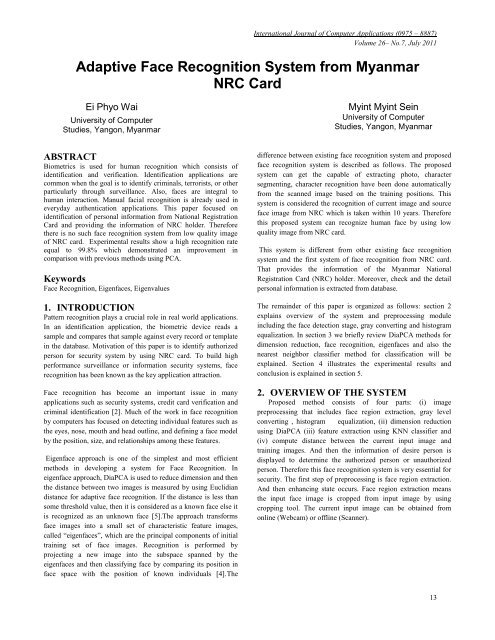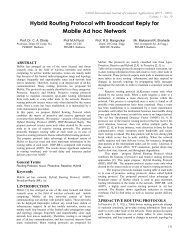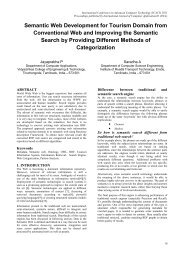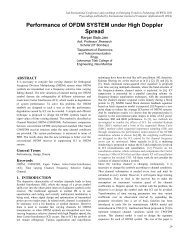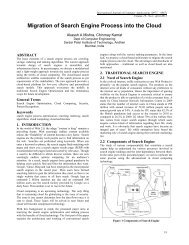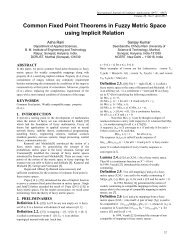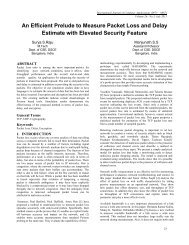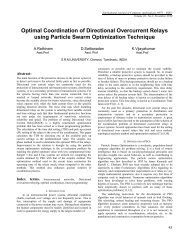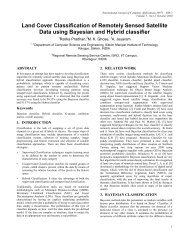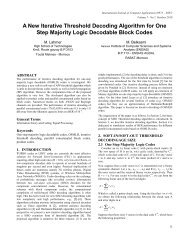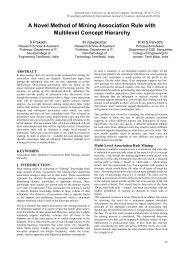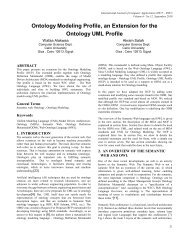Adaptive Face Recognition System from Myanmar NRC Card
Adaptive Face Recognition System from Myanmar NRC Card
Adaptive Face Recognition System from Myanmar NRC Card
You also want an ePaper? Increase the reach of your titles
YUMPU automatically turns print PDFs into web optimized ePapers that Google loves.
International Journal of Computer Applications (0975 – 8887)<br />
Volume 26– No.7, July 2011<br />
<strong>Adaptive</strong> <strong>Face</strong> <strong>Recognition</strong> <strong>System</strong> <strong>from</strong> <strong>Myanmar</strong><br />
<strong>NRC</strong> <strong>Card</strong><br />
Ei Phyo Wai<br />
University of Computer<br />
Studies, Yangon, <strong>Myanmar</strong><br />
Myint Myint Sein<br />
University of Computer<br />
Studies, Yangon, <strong>Myanmar</strong><br />
ABSTRACT<br />
Biometrics is used for human recognition which consists of<br />
identification and verification. Identification applications are<br />
common when the goal is to identify criminals, terrorists, or other<br />
particularly through surveillance. Also, faces are integral to<br />
human interaction. Manual facial recognition is already used in<br />
everyday authentication applications. This paper focused on<br />
identification of personal information <strong>from</strong> National Registration<br />
<strong>Card</strong> and providing the information of <strong>NRC</strong> holder. Therefore<br />
there is no such face recognition system <strong>from</strong> low quality image<br />
of <strong>NRC</strong> card. Experimental results show a high recognition rate<br />
equal to 99.8% which demonstrated an improvement in<br />
comparison with previous methods using PCA.<br />
Keywords<br />
<strong>Face</strong> <strong>Recognition</strong>, Eigenfaces, Eigenvalues<br />
1. INTRODUCTION<br />
Pattern recognition plays a crucial role in real world applications.<br />
In an identification application, the biometric device reads a<br />
sample and compares that sample against every record or template<br />
in the database. Motivation of this paper is to identify authorized<br />
person for security system by using <strong>NRC</strong> card. To build high<br />
performance surveillance or information security systems, face<br />
recognition has been known as the key application attraction.<br />
<strong>Face</strong> recognition has become an important issue in many<br />
applications such as security systems, credit card verification and<br />
criminal identification [2]. Much of the work in face recognition<br />
by computers has focused on detecting individual features such as<br />
the eyes, nose, mouth and head outline, and defining a face model<br />
by the position, size, and relationships among these features.<br />
Eigenface approach is one of the simplest and most efficient<br />
methods in developing a system for <strong>Face</strong> <strong>Recognition</strong>. In<br />
eigenface approach, DiaPCA is used to reduce dimension and then<br />
the distance between two images is measured by using Euclidian<br />
distance for adaptive face recognition. If the distance is less than<br />
some threshold value, then it is considered as a known face else it<br />
is recognized as an unknown face [5].The approach transforms<br />
face images into a small set of characteristic feature images,<br />
called “eigenfaces”, which are the principal components of initial<br />
training set of face images. <strong>Recognition</strong> is performed by<br />
projecting a new image into the subspace spanned by the<br />
eigenfaces and then classifying face by comparing its position in<br />
face space with the position of known individuals [4].The<br />
difference between existing face recognition system and proposed<br />
face recognition system is described as follows. The proposed<br />
system can get the capable of extracting photo, character<br />
segmenting, character recognition have been done automatically<br />
<strong>from</strong> the scanned image based on the training positions. This<br />
system is considered the recognition of current image and source<br />
face image <strong>from</strong> <strong>NRC</strong> which is taken within 10 years. Therefore<br />
this proposed system can recognize human face by using low<br />
quality image <strong>from</strong> <strong>NRC</strong> card.<br />
This system is different <strong>from</strong> other existing face recognition<br />
system and the first system of face recognition <strong>from</strong> <strong>NRC</strong> card.<br />
That provides the information of the <strong>Myanmar</strong> National<br />
Registration <strong>Card</strong> (<strong>NRC</strong>) holder. Moreover, check and the detail<br />
personal information is extracted <strong>from</strong> database.<br />
The remainder of this paper is organized as follows: section 2<br />
explains overview of the system and preprocessing module<br />
including the face detection stage, gray converting and histogram<br />
equalization. In section 3 we briefly review DiaPCA methods for<br />
dimension reduction, face recognition, eigenfaces and also the<br />
nearest neighbor classifier method for classification will be<br />
explained. Section 4 illustrates the experimental results and<br />
conclusion is explained in section 5.<br />
2. OVERVIEW OF THE SYSTEM<br />
Proposed method consists of four parts: (i) image<br />
preprocessing that includes face region extraction, gray level<br />
converting , histogram equalization, (ii) dimension reduction<br />
using DiaPCA (iii) feature extraction using KNN classifier and<br />
(iv) compute distance between the current input image and<br />
training images. And then the information of desire person is<br />
displayed to determine the authorized person or unauthorized<br />
person. Therefore this face recognition system is very essential for<br />
security. The first step of preprocessing is face region extraction.<br />
And then enhancing state occurs. <strong>Face</strong> region extraction means<br />
the input face image is cropped <strong>from</strong> input image by using<br />
cropping tool. The current input image can be obtained <strong>from</strong><br />
online (Webcam) or offline (Scanner).<br />
13
International Journal of Computer Applications (0975 – 8887)<br />
Volume 26– No.7, July 2011<br />
(d) (e) (f)<br />
Dimension reduction by DiaPCA<br />
Feature extraction using KNN<br />
Register /<br />
Preprocessing<br />
<strong>Face</strong><br />
Cropped image<br />
Matching<br />
database<br />
Display result<br />
Fig 1: Overview of the proposed system<br />
Enhancing states include the noise filtering, gray scale converting,<br />
and histogram equalization. After the face region is extracted <strong>from</strong><br />
the scene, the input color image is converted to gray image and<br />
stored in database for processing.<br />
After gray level converting, histogram equalization is occurred.<br />
Histogram equalization maps the input image‟s intensity values so<br />
that the histogram of the resulting image will have an<br />
approximately uniform distribution [7-10]. Through this<br />
adjustment, the intensity can be better distributed on the<br />
histogram.<br />
Fig 2: (a) input image(b) face region extraction (c) gray scale<br />
converting (d) histogram equalization (e) histogram for<br />
original image (f) histogram for equalized image<br />
By histogram equalization, the local contrast of the object in the<br />
image is increased, especially when the usable data of the image is<br />
represented by close contrast values. Through this adjustment, the<br />
intensity can be better distributed on the histogram. This allows<br />
for areas of lower local contrast to gain a higher contrast without<br />
affecting the global contrast.<br />
3. PCA AND DIAPCA<br />
The Principal Component Analysis (PCA) is one of the most<br />
successful techniques that have been used in image recognition<br />
and compression. PCA is a statistical method under the broad title<br />
of factor analysis. The purpose of PCA is to reduce the large<br />
dimensionality of the data space to the smaller intrinsic<br />
dimensionality of feature space, which are needed to describe the<br />
data economically. This is the case when there is a strong<br />
correlation between observed variables. PCA can do prediction,<br />
redundancy removal, feature extraction, data compression, etc.<br />
Because PCA is a classical technique which can do something in<br />
the linear domain, applications having linear models are suitable,<br />
such as signal and image processing.<br />
We have implemented PCA procedure in a training set of M face<br />
images. Let a face image be represented as a two dimensional N<br />
by N array of intensity values, or a vector of dimension N2. Then<br />
PCA tends to find a M-dimensional subspace whose basis vectors<br />
correspond to the maximum variance direction in the original<br />
image space. This new subspace is normally lower dimensional<br />
(M
International Journal of Computer Applications (0975 – 8887)<br />
Volume 26– No.7, July 2011<br />
generated using eigenvectors of scatter matrix, sometimes this is<br />
also called as eigenspace.<br />
The eigenvectors corresponding to nonzero eigenvalues of the<br />
covariance matrix produce an orthonormal basis for the subspace<br />
within which most image data can be represented with a small<br />
amount of error. The eigenvectors are sorted <strong>from</strong> high to low<br />
according to their corresponding eigenvalues. The eigenvector<br />
associated with the largest eigenvalue is one that reflects the<br />
greatest variance in the image. That is, the smallest eigenvalue is<br />
associated with the eigenvector that finds the least variance.<br />
The vectors are also images, so called, eigenimages, or eigenfaces<br />
.They can be viewed as images and indeed look like faces. So<br />
describes the contribution of each eigenface in representing the<br />
facial image by treating the eigenfaces as a basis set for facial<br />
images. <strong>Face</strong> space forms a cluster in image space and PCA gives<br />
suitable representation.<br />
Pattern recognition in high-dimensional spaces have pattern<br />
problems because of curse of dimensionality. Significant<br />
improvements can be achieved by first mapping the data into a<br />
lower-dimensional sub-space. The goal of PCA is to reduce the<br />
dimensionality of the data while retaining as much as possible of<br />
the variation present in the original dataset.<br />
Our motivation for developing the DiaPCA method originates<br />
<strong>from</strong> an essential observation on the PCA. PCA only reflects the<br />
information between rows, which implies some structure<br />
information (e.g. regions of a face like eyes, nose, etc.) cannot be<br />
uncovered by it. We attempt to solve that problem by<br />
transforming the original face images into corresponding diagonal<br />
face images. Because the rows (columns) in the transformed<br />
diagonal face images simultaneously integrate the information of<br />
rows and columns in original images, it can reflect both<br />
information between rows and columns. DiaPCA may find some<br />
useful block or structure information for recognition in original<br />
images. DiaPCA directly seeks the optimal projective vectors<br />
<strong>from</strong> diagonal face images without image-to-vector<br />
transformation.<br />
In the core of our system lies the Diagonal Principal Component<br />
Analysis (DiPCA) Algorithm [2], which is a tested and widely<br />
adopted for face recognition. DiaPCA can be subdivided into two<br />
components – PCA subspace training and PCA projection. During<br />
PCA subspace training, the rows of the pixels of an N1 x N2<br />
image are concatenated into a one dimensional „image vector‟.<br />
DiaPCA is a standard technique used to approximate the original<br />
data with lower dimensional feature vectors. The basic approach<br />
is to compute the eigen vectors of covariance matrix and<br />
approximate the original data by a linear combination of the<br />
leading eigenvectors.<br />
During DiaPCA projection, a new face image vector is multiplied<br />
by the transformation matrix and projected to a point in a high<br />
dimensional DiaPCA subspace. In this case, the correlations<br />
among the projected images are minimized in order to facilitate<br />
easier classification [3]. The projected image is then saved as the<br />
face template of the corresponding user for future matching.<br />
The eigenface-based face analysis that is based on the PCA for<br />
efficient face recognition [5]. In the training phase of the<br />
eigenface method, eigenvectors are calculated with a number of<br />
training faces. The computed eigenvectors are called as<br />
eigenfaces. Then, faces are enrolled in the face recognition system<br />
by their projection onto the eigenface space. In the recognition<br />
phase, an unknown input face can be identified by measuring the<br />
distances of the projected coefficients between the input face and<br />
the enrolled faces in database. The eigenface can be calculated by<br />
using the following equation.<br />
A=u 1 1-v,…,u 1 n-v,u P 1-v,…,u P n-v (2)<br />
To calculate eigenfaces , first calculate average face (v) . And<br />
then collect differences between training images and average face<br />
in matrix A ( M by N) where M is the number of pixels and N is<br />
the number of images .<br />
C=AA T (3)<br />
The eigenvectors of covariance matrix C ( M by M ) give the<br />
eigenfaces.<br />
3.1. Nearest Neighbor Classification<br />
Classification (similarity search) is a very crucial step in any<br />
pattern recognition application. One of the most popular nonparametric<br />
techniques is the Nearest Neighbor classification<br />
(NNC). KNN classifier has many advantages. This is easy to<br />
compute and very efficient. KNN is very compatible and obtain<br />
less memory storage. So it has good discriminative power. KNN<br />
is very robust to image distortions (e.g. rotation, illumination).<br />
Therefore KNN can provide the components that describe the<br />
highest variance and produce good result. So this research can<br />
produce good result by combining DiaPCA and KNN ( K th nearest<br />
neighbor classifier).<br />
3.2. <strong>Face</strong> <strong>Recognition</strong><br />
Dimension of an image space is so high that it is often impractical<br />
to deal with all the data of images in their own dimensions.<br />
DiaPCA enables to optimally reduce the dimensionality by<br />
constructing the eigenface space that is composed of the<br />
eigenvectors [5]. A face image is transformed by projecting it<br />
onto the eigenface space. And then the input face image is<br />
compared the eigenface of database for intelligent face<br />
recognition.<br />
<strong>Face</strong> recognition has many applicable areas. The most useful<br />
applications contain crowd surveillance, video content indexing,<br />
personal identification (eg. driver‟s license), entrance security,<br />
etc. The main idea of using DiaPCA for face recognition is to<br />
15
International Journal of Computer Applications (0975 – 8887)<br />
Volume 26– No.7, July 2011<br />
reduce the large dimension constructed <strong>from</strong> 2-D facial image into<br />
the compact principal components of the feature space. This can<br />
be called eigenspace projection. Once the eigenfaces have been<br />
computed, several types of decision can be made depending on<br />
the application.<br />
The images with a low correlation can be rejected or these two<br />
issues are altogether addressed by categorizing following four<br />
regions:<br />
Near face space and near stored face => known faces<br />
Near face space but not near a known face => unknown<br />
faces<br />
Distant <strong>from</strong> face space and near a face class => nonfaces<br />
Distant <strong>from</strong> face space and not near a known class =><br />
non-faces<br />
Number of eigen-vector depend on the application and accuracy,<br />
it is clear that if the system compute large number of eigenvectors<br />
accuracy of the method improved but computational<br />
complexity increased in this step and next step. In this stage, the<br />
system computed 100 most significant eigenvectors and related<br />
eigen-faces.<br />
This system is implemented by MATLAB. The graphic user<br />
interface is applied for developed system implementation. The<br />
main menu of the developed program is described in figure 4.<br />
Since a face is well represented by the face space, its<br />
reconstruction should be similar to the original and the<br />
reconstruction error will be small. Non-face images will have a<br />
large reconstruction error which is larger than some threshold.<br />
There have been many methods proposed for face recognition.<br />
And one of the key components of any methods is a facial feature<br />
extraction. Facial feature could be a gray-scale-image.<br />
4. EXPERIMENTAL RESULTS<br />
In this part, the system uses thousands of face images as training<br />
database. Experimental results using MATLAB are demonstrated<br />
in this paper to verify the viability of the proposed face<br />
recognition method. At first the system manually crops the face<br />
image <strong>from</strong> the input images in order to remove the undesired<br />
information and have only face image details. The input image<br />
may be the current color image or the scanned image <strong>from</strong> the<br />
<strong>NRC</strong> card.<br />
Fig 4. The main menu of the program<br />
The image selection box can be seen by clicking „select image<br />
button‟. And then the desire image can be selected <strong>from</strong> the image<br />
selection box. And the image can be added to database or deleted<br />
<strong>from</strong> database. The user can see the information of database and<br />
can recognize the desire person.<br />
Additional image is stored in database with the id number by<br />
clicking „Add selected image to database‟ button <strong>from</strong> the MENU<br />
box. The information of database is shown by selecting „Database<br />
Info‟ button and show the number of images stored in database.<br />
The main process of this paper is face recognition by clicking<br />
'<strong>Face</strong> <strong>Recognition</strong>' button. First the desire image can be selected<br />
<strong>from</strong> the image selection box and click '<strong>Face</strong> <strong>Recognition</strong>'. And<br />
then the output can be shown illustrated in figure 5.<br />
Fig 3: Region of Interest<br />
16
International Journal of Computer Applications (0975 – 8887)<br />
Volume 26– No.7, July 2011<br />
face recognition method with a high recognition rate. This<br />
research chose 10 persons and considered 40 training image and<br />
20 test image for each person (totally 400 training and 200 test<br />
face images). Experimental results show a high recognition rate<br />
equal to 99.8% (in average one misclassification for each 200 face<br />
images) which demonstrated an improvement in comparison with<br />
previous methods using PCA. The new face recognition algorithm<br />
can be used in many applications such as security methods.<br />
Fig 5. The result of the program<br />
The next processes are delete database, information, and exit the<br />
program. When click delete database button, delete the entire<br />
database and can see the number of stored images by clicking<br />
information button. When click Exit button, can exit MATLAB<br />
platform.<br />
No.<br />
Feature<br />
Extraction<br />
Method<br />
<strong>Recognition</strong><br />
Rate<br />
(%)<br />
Error<br />
(%)<br />
1. PCA only 93.5 2.9<br />
2. PCA+SVM 96.5 1.32<br />
3. PCA+LDA 98.7 1.92<br />
4. DiaPCA+KNN 99.8 1.2<br />
Fig 6. Comparison of different approaches<br />
According to this comparison, the proposed method has the best<br />
recognition rate and the least error rate based on thousands of test<br />
face images.<br />
5. CONCLUSION<br />
In this paper, a new <strong>Face</strong> recognition method is presented. The<br />
new method was considered as a combination of DiaPCA and<br />
KNN classifier. This system can be used to construct efficient<br />
6. REFERENCES<br />
[1] A. Jain, R. Bolle, S. Pankanti Eds, “BIOMETRIC – Personal<br />
Identification in Networked Society”, Kluwer<br />
AcademicPublishers, Boston/ Dordrecht/ London, 2007.<br />
[2] B. Moghaddam, “Principal manifolds and probabilistic<br />
subspaces for facel recognition", IEEE Trans. pattern Anal.<br />
Machine Intel., Vol. 24, No. 6, PP. 780-788, 2008.<br />
[3] D.L. Swets and J.J. Weng , “Using Discriminant Eigen<br />
features for image retrieval”, IEEE Trans. Pattern Anal.<br />
Machine Intel, vol. 18, PP. 831-836, Aug. 2009.<br />
[4] H. Othman, T. Aboulnasr, " A separable low complexity<br />
2DHMM with application to face recognition" IEEE Trans.<br />
Pattern. Anal. Machie Inell., Vol. 25, No. 10, PP. 1229-1238,<br />
2008.<br />
[5] J. Creed, A Abbott, Optimization of Color Conversion for<br />
<strong>Face</strong> <strong>Recognition</strong>, EURASIP Journal on Applied Signal<br />
Processing, 4: 522-529, 2010.<br />
[6] J. R. Solar, P. Navarreto, " Eigen space-based face<br />
recognition: a comparative study of different approaches,<br />
IEEE Tran. , <strong>System</strong>s man And Cybernetics- part c:<br />
Applications, Vol. 35, No. 3, 2005.<br />
[7] M. Turk, A. Pentland, "Eigen faces for face recognition",<br />
Journal cognitive neuroscience, Vol. 3, No.1, 2008.<br />
[8] O.Deniz, M. Castrill_on, M. Hern_andez, “<strong>Face</strong> recognition<br />
using independent component analysis and support vector<br />
machines” , Pattern <strong>Recognition</strong> letters, Vol. 24, PP. 2153-<br />
2157, 2010.<br />
[9] P.N. Belhumeur, J.P. Hespanha, and D. J. Kriegman,<br />
“Eigenfaces vs. Fisher faces: <strong>Recognition</strong> using class specific<br />
linear projection”, IEEE Trans. Pattern Anal. Machine Intel.,<br />
vol. 19, PP. 711-720, may 2008.<br />
[10] S. H Ou, Q. L. Wang, Z. Y. Zhu. The Application and<br />
Technology of Digital Image Processing. Beijing: Tsinghua<br />
Press, 2010.<br />
17


